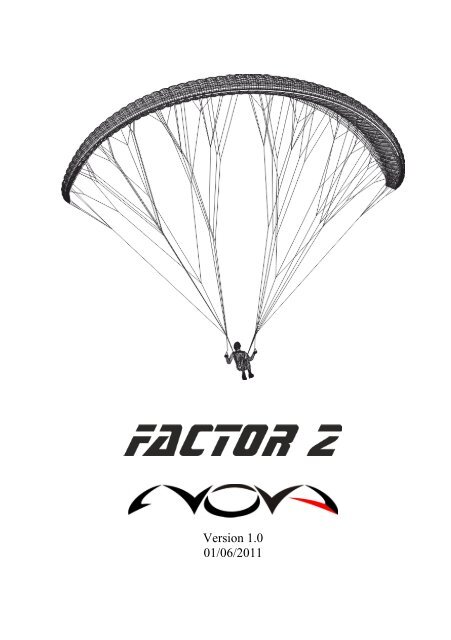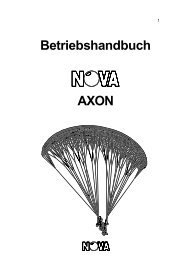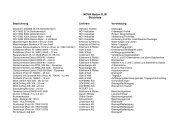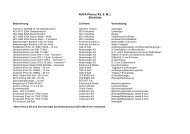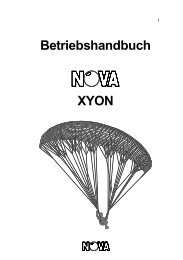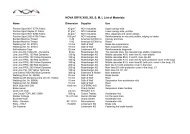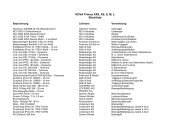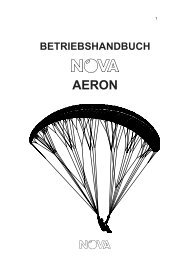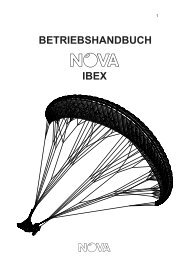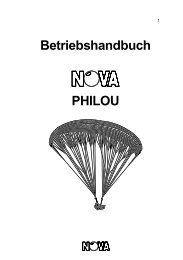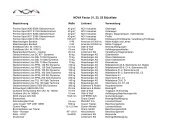Version 1.0 01/06/2011 - Nova Paragliding
Version 1.0 01/06/2011 - Nova Paragliding
Version 1.0 01/06/2011 - Nova Paragliding
You also want an ePaper? Increase the reach of your titles
YUMPU automatically turns print PDFs into web optimized ePapers that Google loves.
<strong>Version</strong> <strong>1.0</strong><br />
<strong>01</strong>/<strong>06</strong>/2<strong>01</strong>1
NOVA ....................................................................................... 6<br />
The FACTOR 2 ....................................................................... 7<br />
Short technical description ......................................................... 7<br />
Safety ............................................................................................ 7<br />
Handling Characteristics ............................................................ 8<br />
Performance ................................................................................. 8<br />
Target Group ............................................................................... 8<br />
General information bevor implementing ............................... 10<br />
First flight ................................................................................ 10<br />
Registration .............................................................................. 10<br />
Scope of delivery ........................................................................ 10<br />
Modifications on the glider ....................................................... 10<br />
Adjusting the length of the main brake line ............................ 10<br />
Suited harnesses ......................................................................... 11<br />
Weight range .............................................................................. 11<br />
Flying the FACTOR 2 .......................................................... 12<br />
Launch ........................................................................................ 12<br />
Normal flight .............................................................................. 13<br />
Turning ....................................................................................... 14<br />
Landing ....................................................................................... 14<br />
Manoeuvres for fast decent ....................................................... 15<br />
Big ears .................................................................................... 15<br />
B-Stall ...................................................................................... 15<br />
Deep spiral ............................................................................... 15<br />
Vers.<strong>1.0</strong><br />
0<strong>1.0</strong>6.2<strong>01</strong>1 S. 2 / 39
C-Stall ...................................................................................... 17<br />
Collapses ..................................................................................... 17<br />
Asymmetric collapse ............................................................... 17<br />
Front tuck ................................................................................. 17<br />
Stall manoeuvres ........................................................................ 18<br />
Spin .......................................................................................... 18<br />
Fullstall .................................................................................... 18<br />
Deep/Parachutal stall ............................................................... 18<br />
Cravates ...................................................................................... 19<br />
Winch launch ............................................................................. 20<br />
Speed system .............................................................................. 20<br />
Mounting the speed system ..................................................... 20<br />
Using the accelerator in flight ................................................. 21<br />
Service and maintenance ...................................................... 21<br />
General advice ........................................................................... 21<br />
Cleaning ...................................................................................... 22<br />
Repair ......................................................................................... 22<br />
Check .......................................................................................... 22<br />
Environment friendly behaviour ......................................... 23<br />
Disposal .................................................................................. 23<br />
Technical data ....................................................................... 24<br />
Overview Glider .................................................................... 26<br />
Line plans ............................................................................... 27<br />
Over all line lengths: ............................................................. 30<br />
Vers.<strong>1.0</strong><br />
0<strong>1.0</strong>6.2<strong>01</strong>1 S. 3 / 39
Check instruction .................................................................. 30<br />
Introduction ............................................................................... 30<br />
Personel requirements for performing a check ...................... 30<br />
Necessary documents and devices for performing a check .... 30<br />
Check intervall ........................................................................... 31<br />
Performing the Check ............................................................... 31<br />
Identifying the glider ............................................................... 31<br />
Checking the porosity .............................................................. 31<br />
Checking the cloth strength ..................................................... 32<br />
Visual inspection of the canopy ............................................... 32<br />
Check of the line condition ...................................................... 33<br />
Measuring the line strength ..................................................... 33<br />
Gliders with Dyneema lines on all A-lines and B-lines ........... 34<br />
Minimum required strength for the lower and mid lines ......... 35<br />
Checking the risers .................................................................. 38<br />
Measuring the line lengths ....................................................... 38<br />
Documentation ........................................................................... 38<br />
Vers.<strong>1.0</strong><br />
0<strong>1.0</strong>6.2<strong>01</strong>1 S. 4 / 39
Congratulations, for choosing to fly a NOVA FACTOR 2. You have got a<br />
glider, to experience exiting and safe flights for many years.<br />
This manual contains important information and instructions to use your glider.<br />
Please read the following pages carefully before your first flight. For questions<br />
and suggestions please contact us: info@nova-wings.com.<br />
To find further information about this or other products please visit our<br />
website: www.nova-wings.com<br />
To fully use all our maintainance and guarantee services you have to register<br />
your glider on our website. (click LOGIN & REGISTRATION)<br />
For more information on our guarantee services have a look here:<br />
http://www.nova-wings.com/english/nova/guarantee.html<br />
Now we wish you many nice ours in the air and a safe landing at the end of<br />
every flight.<br />
NOVA Team<br />
Vers.<strong>1.0</strong><br />
0<strong>1.0</strong>6.2<strong>01</strong>1 S. 5 / 39
NOVA<br />
Since the company was founded in 1989, NOVA has become one of the<br />
world’s leading paraglider manufacturers with their head office in<br />
Terfens/Austria.<br />
NOVA consists of a highly qualified team and most of the team members share<br />
the passion of flying with those pilots, who decided to fly a NOVA glider.<br />
This passion and our Know-How are the fundamental parts of our work. By<br />
now, the passion and the Know-How are continuously growing. This is why we<br />
are for example pioneers in the area of air flow simulations, which allows us to<br />
predict certain properties of a new wing quite accurately on the computer.<br />
Last but not least we have outstanding test pilots who provide a substantial<br />
contribution to make every new wing an unmistakable NOVA glider, which<br />
impresses in every aspect.<br />
But NOVA doesn’t only just stand for the development and the design of<br />
paragliders. We also want to take the responsibility for the manufacture of our<br />
gliders. That’s why the production of NOVA-gliders takes place in our factory<br />
in the Hungarian town of Pecs. This allows us to influence important factors,<br />
for example quality assurance during the whole production process.<br />
Furthermore we can guarantee fair working conditions for about 100 NOVAemployees<br />
in Hungary.<br />
We are convinced that the customer benefits from better employee working<br />
conditions, in terms of high-quality products.<br />
What we want to achieve are happy and enthusiastic pilots, because the future<br />
of our sport depends on the enthusiasm of the people who are part of this<br />
wonderful sport.<br />
Vers.<strong>1.0</strong><br />
0<strong>1.0</strong>6.2<strong>01</strong>1 S. 6 / 39
The FACTOR 2<br />
The FACTOR 2 is the successor of the well known and very successful<br />
FACTOR 1. The glider is a high performance EN C glider, which is dedicated<br />
to pilots with a solid amount of experience. For those pilots, the FACTOR 2<br />
offers outstanding performance, a very pleasant handling characteristic and a<br />
lot of safety in practical conditions.<br />
Short technical description<br />
The FACTOR 2 has 61 cells. Six of those cells are closed stabilo cells on each<br />
side.<br />
There are three layers of lines. The first layer, the A-lines are red. B and C lines<br />
are yellow. The brake layer, which is not one of the three line layers, is<br />
orange/red.<br />
The risers consist of 4 belts. On the first two belts (red) both A stem lines are<br />
attached. Furthermore the speed system is fixed on the first A belt. On the next<br />
two belts the B and C stem lines are attached.<br />
Safety<br />
No matter if flying accelerated or at trim speed, the FACTOR 2 pilot can rely<br />
on a very stable wing in turbulent conditions. If a collapse occurs, it tends to be<br />
quite small and the reopening occurs without impulsiveness. The responsive<br />
brake and the increasing brake pressure helps to avoid an unintended stall when<br />
counter braking after a collapse.<br />
The rather small aspect ratio makes cravats very unlikely.<br />
The overall behaviour of the Factor 2 is very predictable for pilots with the<br />
proper amount experience.<br />
We recommend to all Factor 2 pilots to test the behaviour after collapses<br />
themselves (during an SIV) to get their own impression.<br />
Vers.<strong>1.0</strong><br />
0<strong>1.0</strong>6.2<strong>01</strong>1 S. 7 / 39
Handling Characteristics<br />
To optimise the handling characteristics the Factor 1 was our reference. We<br />
managed to further improve the handling behaviour: The Factor 2 is even more<br />
responsive and can be piloted very precisely. At the same time it offers enough<br />
pitch and roll stability to relax experienced pilots during long flights, as well as<br />
in turbulent conditions.<br />
No matter if you want to fly wingovers, or if you want to stay inside a very<br />
strong thermal: The Factor 2 flies wherever you want it to move. The rather low<br />
aspect ratio and the high stability of the glider lead to a very balanced and easy<br />
handling characteristic.<br />
Flying the Factor 2 is a lot of fun. But we also worked hard to improve the<br />
accelerated flight characteristics: The pressure to push the speed system is very<br />
small and the stability in accelerated flight is very high. This allows to<br />
comfortably use the whole speed range of the glider.<br />
Performance<br />
After the big performance gain, which we could achieve from Mentor 1 to<br />
Mentor 2 our goals were quite ambitious for the Factor 2, and we could finally<br />
reach them.<br />
The Factor 2 glides clearly better than the Mentor 2 and the top speed is<br />
significantly higher.<br />
But glide performance in general and accelerated glide performance in<br />
particular doesn’t help a lot if the glider is not stable enough to fly through<br />
bumpy air without collapses. The Factor 2 excels in such conditions and cuts<br />
through turbulence with high pitch stability. Due to the small operating forces<br />
of the speed system it is easy to perform pitch corrections if necessary.<br />
Target Group<br />
The FACTOR 2 aims to appeal to pilots who have already gathered solid<br />
experience with lower rated gliders and want to enjoy the next level of handling<br />
characteristics and performance. The FACTOR 2 is also interesting for pilots<br />
who used to fly more demanding and who are looking for more passive safety.<br />
Vers.<strong>1.0</strong><br />
0<strong>1.0</strong>6.2<strong>01</strong>1 S. 8 / 39
Due to the outstanding performance, the FACTOR 2 is very interesting for XC<br />
pilots, who are looking for an excellent balance between performance and<br />
safety.<br />
Pilots requirements:<br />
The FACTOR 2 is a High Performance glider, which offers a very precise and<br />
dynamic handling behaviour. We only recommend the glider for pilots who are<br />
very well in control of certain techniques, like controlling a glider in turbulent<br />
conditions: The pilot should be able to prevent unwanted pitch or roll<br />
movement in bumpy air automaticly. If the pilot enters a strong thermal, he<br />
should intuitionally release the brakes to stop the glider from pitching<br />
backwards. When flying into sinking air, the pilot should apply more brakes.<br />
The FACTOR 2 pilot should also be able to easily fly steep turns without<br />
unwanted pendulum movement. We think, that a pilot, who is not capable of<br />
those basic techniques will not be able to use the huge performance potential of<br />
the FACTOR 2.<br />
To react quickly and without thinking is also necessary after collapses. We<br />
think, that this can only be achieved by training, which means by inducing<br />
collapses. (for example by attending a SIV) Training can also mean to spend<br />
some time on a training hill to work on your ground handling and take-off<br />
technique.<br />
All this will help you, to get a better understanding of your glider and to<br />
become a better pilot.<br />
Every pilot, who flies on their own has to be able to decide if their skills and<br />
equipment is adequate for the respective conditions. The FACTOR 2 offers a<br />
high level of safety for a pilot with proper skills, but misjudgements may still<br />
have serious consequences.<br />
The best way to avoid misjudgements is a defensive approach to the sport.<br />
Sometimes it makes sense to pass on a flight, instead of getting yourself into<br />
conditions you cannot handle. Regular training improves your skills and<br />
enables you to enjoy your flights, even in more difficult conditions.<br />
If you don’t meet the requirements for such a glider, you won’t be able to use<br />
the potential of the FACTOR 2. You will fly longer, further, safer and with<br />
more joy with a lower rated wing, like the MENTOR 2 for example.<br />
Vers.<strong>1.0</strong><br />
0<strong>1.0</strong>6.2<strong>01</strong>1 S. 9 / 39
Please consider these thoughts!<br />
General information bevor implementing<br />
First flight<br />
Every NOVA glider has to be flown and checked through a NOVA dealer. This<br />
flight (date and pilot) has to be entered on the stabilo of the wing.<br />
Registration<br />
To get all warranty and service features, you have to register your glider on our<br />
Homepage. Please choose “LOGIN®ISTRATION” and follow the advice<br />
for registration<br />
Scope of delivery<br />
The FACTOR 2 is shipped with a rucksack, an inner pack sack, a riserbag, the<br />
speed system, a windsock, the manual and a patch.<br />
Modifications on the glider<br />
Any modification (e.g. change of line lengths, changes on the speed system)<br />
causes a loss of air worthiness. We recommend that you contact NOVA before<br />
performing any kind of change.<br />
Adjusting the length of the main brake line<br />
Especially if you use your glider with a motor it might be necessary to lengthen<br />
your main brake line. You have to make sure, that the length of both brakes is<br />
always the same. Further more you have to use a palstek to mount the brake<br />
handle to the brake line. (see picture below)<br />
If you adjust the brake lengths for motor use, do not forget to shorten it again<br />
before flying the wing without a motor. Otherwise you might experience<br />
serious problems at take off.<br />
The brake line must not be shorter than the original length. The black mark has<br />
to be always visible like shown in the picture below.<br />
If the brake line is shorter, this might affect the safety of your glider.<br />
Vers.<strong>1.0</strong><br />
0<strong>1.0</strong>6.2<strong>01</strong>1 S. 10 / 39
Palstek<br />
Suited harnesses<br />
The FACTOR 2 is approved for any harness of the class “GH” (without<br />
diagonal bracing). This means almost every harness which is currently<br />
available.<br />
The choice of the harness has a big influence on the flight characteristics of the<br />
FACTOR 2. There are harnesses which allow very effective weight shifting on<br />
the one hand, but which tip to the side in turbulences quite undamped on the<br />
other hand.<br />
Other harnesses don’t allow extreme weight shifting, but they will give the pilot<br />
a calmer feel in turbulent conditions.<br />
A good flying school can help on this topic with individual advice.<br />
Weight range<br />
Each size of the FACTOR 2 is certified for a certain weight range. The weight<br />
refers to the “overall take off weight”. This means the weight of the pilot, the<br />
glider, the harness and all other equipment.<br />
If you fly the FACTOR 2 on the lower half of the weight range, the agility<br />
decreases and the glider will be more damped. In strong turbulences the wing<br />
tends to deform and to collapse slightly more than with a higher wing loading.<br />
If you mainly fly in weak conditions and you are not a fan of a very dynamic<br />
Vers.<strong>1.0</strong><br />
0<strong>1.0</strong>6.2<strong>01</strong>1 S. 11 / 39
flight behaviour, you should consider flying the FACTOR 2 in this weight<br />
range.<br />
If you fly the FACTOR 2 on the upper half of the weight range, the agility and<br />
the stability in turbulences will increase. Also the speed will increase slightly.<br />
The self damping will decrease in turns, as well as after collapses, so if you<br />
often plan to fly in bumpy conditions and you want a dynamic flight<br />
characteristic you should go for the top of the weight range.<br />
Flying the FACTOR 2<br />
We suggest performing your first flights with a new wing in calm conditions to<br />
get used to the flight behaviour without any stress. We also recommend to do<br />
some take-offs on a training hill or some ground handling to get a good feeling<br />
for your glider from the very beginning.<br />
Launch<br />
Before every take off the pilot has to ensure that the equipment is in a proper<br />
condition, especially the glider, the harness and the reserve system.<br />
Just before launch we recommend a check routine, which should be performed<br />
carefully. (Many accidents at take off could be avoided by a proper check!)<br />
We recommend the following routine:<br />
1.) Strapped up (Leg strap and chest strap on the harness and helmet strap<br />
all done up)<br />
2.) Clipped in (Risers untwisted and connected to the karabiners, speed<br />
system attached and karabiners properly closed)<br />
3.) Lines (A lines on top, all lines sorted, brake line unlooped between<br />
brake handle and pulley)<br />
4.) Glider (glider lies arched with opened cell openings at take off.)<br />
5.) Wind and airspace (wind suitable for launch and airspace in front of<br />
take off free of other gliders)<br />
Vers.<strong>1.0</strong><br />
0<strong>1.0</strong>6.2<strong>01</strong>1 S. 12 / 39
The FACTOR 2 has a very well balanced and easy take off behaviour.<br />
Corrections are easy to perform at any time and no special advice is needed for<br />
forward or reverse launches.<br />
A proper take off technique can only be learnt by intensive training. That’s why<br />
we recommend to spend some time on a training hill every once in a while.<br />
Also some ground handling will improve your take off skills. The best thing is<br />
to have an experienced pilot with you who can help with some advice.<br />
Like this, you will soon be able to launch your glider confidently, even in<br />
difficult conditions. This will add a lot of safety to your flying and it allows you<br />
to enjoy your flights from the very beginning.<br />
Normal flight<br />
If you release both brakes (“Hands up”) the FACTOR 2 glides at the so called<br />
“trim speed”. At this speed, the glide ratio reaches its maximum.<br />
If you fly into a headwind or through sinking air, you should use the accelerator<br />
to maximise your glide ratio. If you use the accelerator in turbulent conditions,<br />
you have to consider more demanding reactions in the case of a collapse. So<br />
you should keep more distance from the ground if you fly accelerated.<br />
If you fly in strong turbulences we recommend applying both brakes slightly.<br />
This increases the stability and you get good feedback through the brakes,<br />
which is necessary to fly your wing actively.<br />
Flying actively means permanent control and correction of the angle of attack<br />
in turbulent air. If you fly from lift into an area of sinking air, the angle of<br />
attack will decrease and the wing will pitch down. A good pilot will realise this<br />
even before the wing pitches down, by a reduced brake pressure. The right<br />
reaction would be to apply the brakes more and thereby increase brake pressure<br />
to prevent the wing from pitching down or even from collapsing in turbulent<br />
conditions.<br />
Flying from sinking air into lift is just the opposite: Without any pilot action,<br />
the angle of attack would increase and the wing would pitch up. The pilot can<br />
feel this, by an increased brake pressure. In this situation, the pilot should<br />
release the brakes to reduce the pitch movement.<br />
To generalize:<br />
Vers.<strong>1.0</strong><br />
0<strong>1.0</strong>6.2<strong>01</strong>1 S. 13 / 39
If the brake pressure decreases and if the wing pitches down, the pilot should<br />
apply more brakes. If the brake pressure increases and if the wing pitches up,<br />
the brakes should be released.<br />
With proper active flight control, the pilot can avoid most of the collapses and<br />
keep control in every moment. The best way to learn this is of course flying,<br />
but ground handling definitely helps to improve the feeling for the glider. A<br />
good training exercise is to stabilise the wing above your head with the brakes,<br />
without looking at it. This helps as well for improving the forward launch.<br />
Turning<br />
A smooth turn is an interaction of inner brake, outer brake and weight shifting.<br />
The difficulty is finding the right amount, which is important if you want to<br />
climb efficiently in thermals.<br />
The FACTOR 2 turns quite sensitively, so only small inputs are needed for<br />
performing precise turns. Tight and quick turns or fast changes of turning<br />
direction without unwanted pendulum movement are quite complex and take<br />
some training. It should be the goal of every pilot to master these skills<br />
perfectly.<br />
Attention:<br />
If you can’t use the brakes for steering the glider you can use the C-risers<br />
instead. (This might be necessary for example, if the brake lines tangled up due<br />
to a bad pre-launch check or less likely, if the main brake line tears).<br />
The FACTOR 2 can be turned quite well with the C-risers combined with<br />
weight shifting. You can also land the glider nice and smooth just with the Crisers.<br />
Don’t pull the C-risers too much, to avoid a deep stall!<br />
Landing<br />
Landing the FACTOR 2 is very easy. In turbulent conditions we recommend<br />
applying brakes (approximately 20% of the available brake travel) during the<br />
whole approach. This will increase the stability of the glider and the feeling of<br />
the wing.<br />
Vers.<strong>1.0</strong><br />
0<strong>1.0</strong>6.2<strong>01</strong>1 S. 14 / 39
Just before touch down you should apply more brake. Many times it makes<br />
sense to induce a stall.<br />
Attention: A deep stall in just 2 meters height can cause a quite violent<br />
touch down. Make sure to not fully apply the brakes until you are close<br />
enough to the ground.<br />
Manoeuvres for fast decent<br />
Big ears<br />
To do big ears, pull the outer A-line (attached on a separate belt) on both sides.<br />
Keep the brake handles (without extra wraps) in your hands.<br />
As long as you keep both outer A-risers pulled, the wingtips will be folded and<br />
the sink speed will increase. We recommend to additionally push the speed bar<br />
to increase the sink speed further and to also increase forward speed. The drag<br />
of the folded wingtips increases the angle of attack. By pushing the speed bar,<br />
this effect is compensated.<br />
To end the manoeuvre, release the A-risers. If the wingtips don’t open<br />
automatically, you can inflate them by applying the brakes with a short impulse<br />
movement.<br />
B-Stall<br />
Due to the aspect ratio of the glider and due to the suspension layout, the<br />
FACTOR 2 can show a quite demanding behaviour when executing the B-Stall.<br />
But a manoeuvre for fast decent has work perfectly in very turbulent<br />
conditions. That’s why we do not recommend the B-Stall with the FACTOR 2.<br />
Deep spiral<br />
The deep spiral is the most demanding of the three manoeuvres. (Ears, B-Stall<br />
and Deep Spiral) You should only practise it with a lot of altitude. The best<br />
way is to learn it under professional guidance.<br />
Entering a deep spiral can be divided into two phases:<br />
First, you fly a turn by applying one brake and by shifting your weight to the<br />
same side, the glider will bank up and increase its turning speed. This phase<br />
ends at a sink rate of roughly 8m/s – 10m/s. (depending on the wing loading)<br />
Vers.<strong>1.0</strong><br />
0<strong>1.0</strong>6.2<strong>01</strong>1 S. 15 / 39
Then at the beginning of the second phase the g-forces increase rapidly and the<br />
leading edge will lean towards the ground. In a fully developed deep spiral, the<br />
leading edge is almost parallel to the ground. The maximum sink rate with the<br />
FACTOR 2 can get up to 25m/s and more.<br />
The first attempts to fly a deep spiral should be stopped clearly before reaching<br />
the second phase to get used to the quick rotation and to practice the exit<br />
without pendulum swinging. The exit should be performed by simply releasing<br />
the inner brake with a neutral weight-shift. The FACTOR 2 will then decrease<br />
its bank angle and go back to normal flight. To avoid a pendulum movement,<br />
the inner brake has to be pulled in the moment the wing wants to reduce its<br />
bank rapidly.<br />
By applying the inner brake again, you force the glider to exit the spiral<br />
movement not rapidly but during two or three rotations. It is very important to<br />
master this exercise before continuing to the second phase of the deep spiral.<br />
The pilot will feel the entering of this phase by the suddenly increased g-force.<br />
In this moment, the pilot is being pushed to the outer side of the harness. It is<br />
important to not counteract. So the pilot should lean to the outer side to avoid a<br />
stable spiral. (See below)<br />
If the pilot weight shifts to the outer side, the spiral movement will get slower<br />
as soon as the pilot releases the inner brake. The rest of the exit works as<br />
explained above for the first phase of the deep spiral.<br />
If the pilot shifts his weight clearly to the inner side, the FACTOR 2 might stay<br />
in a deep spiral, even when releasing both brakes. In this case, it helps to apply<br />
the outer brake, or both brakes and of course to shift the weight to the outer<br />
side.<br />
Please don’t underestimate the difficulty of learning the deep spiral. The sink<br />
rates are a lot higher than what you are used to from other manoeuvres and the<br />
fast rotation might lead to disorientation. The high g-loads of up to 3g make the<br />
manoeuvre even more demanding as you might have problems like the so<br />
called “black out”, where you temporarily lose your vision due to the g-load. It<br />
is very important to get a feeling for the reactions of your body to this<br />
manoeuvre.<br />
If you practice it well, it is a fun manoeuvre that enables you to loose height<br />
faster than with any other manoeuvre.<br />
Vers.<strong>1.0</strong><br />
0<strong>1.0</strong>6.2<strong>01</strong>1 S. 16 / 39
C-Stall<br />
This manoeuvre can be found sporadically in some paragliding literature. We<br />
don’t recommend it, because entering and exiting the C-stall can be very<br />
demanding and dangerous for many pilots.<br />
Collapses<br />
Asymmetric collapse<br />
If you fly in strong turbulences, one side of the glider might collapse. This<br />
happens if one side of the wing doesn’t produce lift anymore, due to a low<br />
angle of attack. If there is no lift, the lines get loose and the wing deforms or<br />
collapses.<br />
Most of these collapses are rather small – they only affect a small part of the<br />
wingspan. In such a case, the FACTOR 2 continues to fly almost unaffected. If<br />
the collapse affects 50% of the wingspan or more, the wing will react<br />
considerably:<br />
Due to the increased drag of the collapsed wing, the glider will turn to the<br />
collapsed side. Furthermore, the glider will pitch down because of the increased<br />
wing loading. (The glider has to increase its speed because of the reduced area<br />
– that’s what causes the pitching down.)<br />
The pilot can prevent the glider from pitching and turning, by applying the<br />
brake on the non collapsed side of the wing. If a collapse occurs close to the<br />
ground it is essential to react properly. The proper reaction should be taught at<br />
high altitude, ideally under professional guidance.<br />
As explained above, most of the collapses can be prevented, if you fly actively!<br />
Front tuck<br />
A front tuck occurs, if the angle of attack gets too low on the whole wingspan,<br />
then the whole leading edge will collapse. After the asymmetric tuck, the<br />
FACTOR 2 will go back to normal flight automatically. The pilot can expedite<br />
the opening process by slightly applying both brakes.<br />
Vers.<strong>1.0</strong><br />
0<strong>1.0</strong>6.2<strong>01</strong>1 S. 17 / 39
Stall manoeuvres<br />
Spin<br />
If you pull one brake too much, you might induce a so called spin. The centre<br />
of rotation is no longer far outside the wing (like during a normal turn), but it<br />
moves inside the wing. Furthermore the rotation speed increases. The FACTOR<br />
2 will go back to normal flight, if the pilot releases both brakes. The FACTOR<br />
2’s spin behaviour is easily manageable: It takes a lot of brake travel to induce<br />
the spin, and then the pilot has quite some time to react and release both brakes.<br />
Fullstall<br />
If you pull both brakes too far, the wing will perform a so called full stall. The<br />
wing suddenly stops its forward motion, but the pilot is still moving forward.<br />
So from the pilots view, the glider will tilt backwards. It is very important to<br />
not release the brakes in this moment. Otherwise the glider might surge forward<br />
below the pilot.<br />
The Full Stall is a complex manoeuvre and the perfect execution can not be<br />
explained in this manual. If you want to learn a proper full stall, it makes sense<br />
to do this under professional guidance.<br />
The available brake travel before stalling the wing depends on the size. It is<br />
approximately 50 cm for the FACTOR 2 XS, 53cm for the FACTOR 2 S, 58cm<br />
for the FACTOR 2 M, and 62cm for the FACTOR 2 L.<br />
Those numbers are just a rough indication. (The publication of the brake travel<br />
is claimed by the EN 926.)<br />
It would be dangerous to use the brake travel according to those numbers,<br />
because it is not practicable to measure the brake travel during flight, and in<br />
turbulences the stall might occur with less brake travel. If you want to use the<br />
whole brake travel of your glider safely, it is necessary do many intended spins<br />
and full stalls to get a feeling for the stall behaviour.<br />
Deep/Parachutal stall<br />
The Deep Stall, or Parachutal Stall is kind of the pre stage to a Full Stall. The<br />
wing has no forward motion and a high sink speed, but it is almost fully<br />
inflated. The pilot can enter the Deep Stall by applying both brakes. It is very<br />
difficult to keep the wing in a Deep Stall: If you pull the brakes a little too<br />
Vers.<strong>1.0</strong><br />
0<strong>1.0</strong>6.2<strong>01</strong>1 S. 18 / 39
much, the glider will enter a Full Stall. If you release the brakes too much, the<br />
glider will go back to normal flight. To practice a Deep Stall, it is necessary to<br />
master the Full Stall first.<br />
A very old or worn out glider with a porous cloth or with a changed trim (due<br />
to many winch launches, or deep spirals) might stay in a deep stall even after<br />
releasing both brakes. Do not apply the brakes in such a situation, because the<br />
wing would then enter a full stall ! You can exit the deep stall by pushing the<br />
speed bar, or by simply pushing the A-risers forward. If you fly through rain,<br />
the risk of a deep stall is higher. We strongly advice against flying in rainy<br />
conditions. If it happens, that you get into rainfall, we recommend not<br />
performing a B-stall or Big Ears. Our recommendation is to leave the rain as<br />
soon as possible and to fly with both brakes released, or even accelerated, as<br />
this reduces the risk of a deep stall. (The available brake travel before entering<br />
a deep stall may be reduced significantly.)<br />
Cravates<br />
After a big collapse or after a badly executed Full Stall, a part of the wing<br />
might be tangled up in the lines, and won’t reopen automatically. This is what<br />
you call a cravate. During our extensive test flights with the FACTOR 2 we<br />
never experienced a cravate but this situation cannot be eliminated with any<br />
paraglider.<br />
In case of a cravate we recommend the following actions:<br />
1.) Counter steer: Probably the wing wants to turn to the side of the<br />
cravate. In some cases, the turning happens quickly and will end in a<br />
stable deep spiral without the pilot’s action. So it is important to react<br />
quickly by counter steering.<br />
2.) Opening the cravate by applying the brake with an impulse movement:<br />
Some cravats can be opened with this method. It is important to keep<br />
the wing in straight flight by pulling the other brake all the time.<br />
3.) Pulling the stabilo line: Some cravats can be opened by strongly<br />
pulling the stabilo line. (It is the orange line on the B-riser. Have a<br />
look at it or grab it every once in a while and you will be able to react<br />
quicker in a moment of danger.)<br />
Vers.<strong>1.0</strong><br />
0<strong>1.0</strong>6.2<strong>01</strong>1 S. 19 / 39
4.) Full stall: Many cravats can be opened by using the Full Stall. But of<br />
course you have to have solid experience with this manoeuvre to be<br />
able to use it properly.<br />
5.) Induce a collapse: Sometimes it helps to induce a collapse on the side<br />
with the cravatte.<br />
6.) Reserve: If you loose control or if you are not absolutely sure that you<br />
have enough height for further attempts to recover, immediately use<br />
your reserve!<br />
Many pilots wait way too long before using their reserve. Some don’t use the<br />
reserve at all if they lose control of their glider. We strongly recommend to at<br />
least mentally practice the use of the reserve from time to time: Grab the handle<br />
of the reserve in flight, like you would do it in case of emergency. Many clubs<br />
or schools offer to throw the rescue for example in a gym. The most realistic<br />
way of training is to use the reserve in real flight. Many SIV Clinics offer that<br />
as part of their training.<br />
Winch launch<br />
The FACTOR 2 is very easy to launch on the winch. You should start to climb<br />
at a flat angle.<br />
We recommend the use of a towing device which accelerates the glider during<br />
the winch launch.<br />
Speed system<br />
Mounting the speed system<br />
Most harnesses have two pulleys on each side. Some light harnesses have<br />
simple rings instead. Guide the accelerator ropes (included in the delivery)<br />
from top to bottom through these pulleys. Then fix the speed bar on the bottom<br />
of the ropes.<br />
It is important to adjust the length correctly. If you set it too short, the glider<br />
might fly accelerated all the time, which definitely has to be avoided. If you set<br />
it too long, you might not be able to use the full accelerator travel.<br />
Vers.<strong>1.0</strong><br />
0<strong>1.0</strong>6.2<strong>01</strong>1 S. 20 / 39
We suggest adjusting the length quite long and then try to estimate the free<br />
travel in flight to shorten it after the flight.<br />
Using the accelerator in flight<br />
The speed system is very effective and smooth running. The glide performance<br />
is very good up to the maximum speed of the FACTOR 2. Please consider, that<br />
the wing behaves more dynamic if a collapse occurs in accelerated flight. You<br />
should be aware, that you might need more height to recover to normal flight!<br />
Attention: It doesn’t make sense to apply the brakes during accelerated<br />
flight. This will reduce the glide performance considerably, and it will<br />
make the wing more unstable. (Unlike in non accelerated flight!)<br />
To turn, simply shift weight, or push the speed bar asymmetrically. (If you push<br />
the right side further, the wing will perform a left turn.)<br />
You should also use the accelerator for pitch control: If the glider pitches up,<br />
push the speed bar more, if it pitches down, release the speed bar.<br />
Measurements of the speed systems (publication required by EN 926)<br />
If you use all the available accelerator travel, the A riser will get about 17.5cm<br />
shorter than the C riser on the FACTOR 2 S and FACTOR 2 M.<br />
Service and maintenance<br />
General advice<br />
To keep your glider in good condition for many years, please consider the<br />
following advice:<br />
� Don’t expose your glider to unnecessary UV radiation – for example<br />
by leaving it on the landing site unpacked.<br />
� Don’t fold the nylon rod reinforcements at the cell openings too hard.<br />
� If you pack the glider when it is wet or just damp, it has to be dried<br />
later. Don’t leave it packed in a wet condition!<br />
Vers.<strong>1.0</strong><br />
0<strong>1.0</strong>6.2<strong>01</strong>1 S. 21 / 39
� When you practice ground handling, avoid crashing the glider hard on<br />
the ground with the leading edge, as this might lead to damage.<br />
� Avoid unnecessary dirt or sharp stones touching the lines and the<br />
cloth. Don’t step on the lines if they are laying on a stony surface!<br />
� Humidity combined with dirt can lead to shrinking of the lines and<br />
thereby to the wrong trim on your glider. Saltwater (sweat) may<br />
damage the lines in the long run.<br />
� To store your glider for a longer time, avoid a humid or a very hot<br />
environment. (Like in a car during hot summer days)<br />
Cleaning<br />
To clean the wing, only use water and a cleaning cloth. Never use any solvents.<br />
If there is sand, dirt or small stones inside the canopy, you should remove them<br />
because they will damage the coating of the cloth and the seams in the long run.<br />
Repair<br />
Repairs may only be performed by authorised service centres or by NOVA.<br />
You can repair small holes or tears in the cloth (smaller than 5cm) yourself<br />
with a special self adhesive repair tape. (You can order it at NOVA or in any<br />
service centre.) If you are not sure about the damage, or if the damage affects<br />
parts of a seam, please contact NOVA. (info@nova-wings.com)<br />
Check<br />
We suggest a trim inspection (<strong>Nova</strong> Trim Tuning NTT) in the first year after<br />
the date of purchase. In the case that the NTT is done, the next full check (NFS:<br />
NOVA full service) has to be performed 3 years after purchase.<br />
In the case that the NTT is not done, the wing needs a full check after 2 years<br />
after purchase. The check expert can define the next check interval on the basis<br />
of the wing’s condition. In areas where conditions are harsh on the material (i.e.<br />
by salty air and sand next to the coast), an annual complete check (NFS) is<br />
strongly recommended!<br />
Vers.<strong>1.0</strong><br />
0<strong>1.0</strong>6.2<strong>01</strong>1 S. 22 / 39
The date of purchase of the new glider is decisive for any deadline<br />
concerning NTT and NFS, as well as for guarantee.<br />
Attention: In the case of commercially used gliders, (tandems or school<br />
gliders) the NFS has to be performed every year.<br />
Independent from the deadlines mentioned above:<br />
A check (NFS) has to be performed not later than every 200 hours of flight, or<br />
every 400 flights. (Depending on what happens first.)<br />
The check has to be confirmed with the check-stamp on the stabilo. All<br />
necessary documents for the inspection can be found on the NOVA homepage<br />
(http://www.nova-wings.com): Downloads: Check.<br />
More information about our check system:<br />
http://www.nova-wings.com/english/info_zone/ntt.html<br />
Environment friendly behaviour<br />
Apart from self-evident things, like not leaving your rubbish behind, we would<br />
like to appeal for a thoughtful behaviour towards animals, like birds of prey or<br />
game animals. If you notice, that your fly by affects those animals (like<br />
causing a shortening reaction) please increase your distance.<br />
Disposal<br />
Disused paragliders need a proper disposal. If you are not sure about the correct<br />
removal, please send your glider to NOVA.<br />
Vers.<strong>1.0</strong><br />
0<strong>1.0</strong>6.2<strong>01</strong>1 S. 23 / 39
Technical data<br />
1 Pilot + total equipment<br />
Size XS S M L<br />
Zoom factor 0.91 0.96 1 <strong>1.0</strong>45<br />
Number of cells 63 63 63 63<br />
Projected wingspan m 8.78 9.27 9.65 10.09<br />
Projected surface area m² 18.2 20.3 22 24.1<br />
Projected aspect ratio 4.23 4.23 4.23 4.23<br />
Flat wingspan m 11.47 12.10 12.61 13.17<br />
Flat surface area m² 21.83 24.3 26.36 28.79<br />
Flat aspect ratio 6.03 6.03 6.03 6.03<br />
Line diameter mm 0.6 / 0.7 / 0.8 / 1.1 / 1.3 / 1.7<br />
Line length m 6.64 7.<strong>01</strong> 7.3 7.63<br />
Line consumption m 233 246 256 268<br />
max. profile depth m 2.38 2.52 2.62 2.74<br />
min. profile depth m 0.6 0.64 0.66 0.69<br />
Weight kg 5.3 5.8 6.3 6.8<br />
Legal take of weight LTF/EN 1 kg 65-90 80-100 90-110 100-130<br />
Places 1 1 1 1<br />
Certification LTF/EN (C) C C (C)<br />
Vers.<strong>1.0</strong><br />
0<strong>1.0</strong>6.2<strong>01</strong>1 S. 24 / 39
Overview risers<br />
1 A1-riser 5 Main suspension loop<br />
2 A2-riser (EARS) 6 Speed clips<br />
3 B-riser (B-Stall) 7 Shackle<br />
4 C-riser 8 Brake handle<br />
Vers.<strong>1.0</strong><br />
0<strong>1.0</strong>6.2<strong>01</strong>1 S. 25 / 39
Overview Glider<br />
1 Stem Lines 5 Cell Openings<br />
2 Middle Lines 6 Top sail<br />
3 Top Lines 7 Trailing edge<br />
4 Bottom sail 8 Nameplate<br />
Vers.<strong>1.0</strong><br />
0<strong>1.0</strong>6.2<strong>01</strong>1 S. 26 / 39
Line plans<br />
Vers.<strong>1.0</strong><br />
0<strong>1.0</strong>6.2<strong>01</strong>1 S. 27 / 39
Line lengths<br />
Factor 2<br />
XS S M L<br />
Linetype Linetype<br />
Factor2 L<br />
Vers.<strong>1.0</strong><br />
0<strong>1.0</strong>6.2<strong>01</strong>1 S. 28 / 39
Vers.<strong>1.0</strong><br />
0<strong>1.0</strong>6.2<strong>01</strong>1 S. 29 / 39
Over all line lengths<br />
You can find the overall line lengths (from the shackle to the loops on the<br />
bottom sail) on the homepage of the Para-Academy. (www.para-academy.eu)<br />
Please note, that you can not calculate the over all length, by just adding the<br />
single line lengths listed above!<br />
Check instruction<br />
Introduction<br />
The NOVA Full Service – NFS (complete check) and the NOVA Trim Tuning<br />
NTT (trim check) shall ensure the flight safety of the paraglider.<br />
Personel requirements for performing a check<br />
Only check centers, which are authorised by NOVA may carry out checks. You<br />
can find all authorised persons / check centre on our homepage: www.novawings.com/english/nova/checkcenter.html<br />
If you have questions about checks in your country, you can either contact<br />
NOVA (info@nova-wings.com), or the NOVA distributor in your country:<br />
www.nova-wings.com/english/nova/distributors.html<br />
Necessary documents and devices for performing a check<br />
� Line plan: www.nova-wings.com/english/downloads/lineplans.html<br />
� List of material: www.nova-wings.com/english/downloads/check.html<br />
� Previous NFS check protocols (if you don’t perform the first NFS on the<br />
glider)<br />
� Line measurement device (Laser telemeter and a special device to ensure<br />
measurement with constant line load – ask NOVA for further information)<br />
� Porosity meter (Kretschmer or JDC)<br />
� „Betsometer“ for checking the cloth strength.<br />
� Line tear machine according to EN926-1:4.6.3<br />
� Maintenance and calibration documentation of all the measurement<br />
devices.<br />
Vers.<strong>1.0</strong><br />
0<strong>1.0</strong>6.2<strong>01</strong>1 S. 30 / 39
Check intervall<br />
We schedule a trim inspection (NOVA Trim Tuning NTT) within the first year<br />
after the date of purchase (new glider) In the case that the NTT is not done, the<br />
wing needs a full check after 2 years after purchase (new glider). The check<br />
expert can define the next check interval on the basis of the wing’s condition.<br />
In areas where conditions are harsh on the material (i.e. by salty air and sand<br />
next to the coast), an annual complete check (NFS) is strongly recommended!<br />
We recommend the same for wings which are used for regular acro flying.<br />
The date of purchase of the new glider is decisive for any deadline concerning<br />
NTT and NFS, as well as for guarantee.<br />
Attention:<br />
In the case of commercially used gliders, (tandems or school gliders) the NFS<br />
has to be performed every year.<br />
Independent from the deadlines mentioned above:<br />
A check (NFS) has to be performed not later than every 200 hours of flight, or<br />
every 400 flights. (Depending on what happens first.)<br />
The check has to be confirmed with the check-stamp on the stabilo. All<br />
necessary documents for the inspection can be found on the NOVA homepage<br />
(http://www.nova-wings.com): Service & Downloads<br />
Performing the Check<br />
Identifying the glider<br />
The glider type and the serial number of the glider can be found on the wing<br />
tip. Please ensure that the certification tag is on the middle rib of the wing.<br />
Checking the porosity<br />
The porosity check has to be performed on 5 spots on the top sail. These spots<br />
have to be clean (no sand, no dust) and without damage (e.g. small holes).<br />
Otherwise the result would be falsified.<br />
The average value on the top sail has to be used to judge the gliders condition.<br />
If one value is a lot lower than the other values, please repeat the measurement<br />
and move the measurement spot slightly.<br />
Vers.<strong>1.0</strong><br />
0<strong>1.0</strong>6.2<strong>01</strong>1 S. 31 / 39
Evaluation of the measurements for the top sail:<br />
JDC Kretschmer Evaluation<br />
15-30 50-100 Strongly used<br />
Check of the line condition<br />
The paraglider has to be spreaded and every single line has to be checked. The<br />
lines have to by manually scanned on their whole length. If you detect a<br />
damage, on the coating or on the core, the line has to be replaced. Furthermore<br />
the sewing and the line loops have to be controlled.<br />
Every damage and repairing has to be entered in the check protocol.<br />
Measuring the line strength<br />
The ripping test has to be carried out at the first NFS. (so 2, or 3 years after<br />
purchase)<br />
How to perform the ripping test:<br />
One lower line and one mid line have to be ripped. The A-lines in the centre of<br />
the wing are the ones with the most loads in flight, so you have to rip the A1<br />
and the A1M (inner mid line).<br />
Attention: If a glider has just two line levels, (only lower lines and top<br />
lines, e.g. Mentor 2) the ripping test has to include the top level. The<br />
strength of the top line has to meet the criteria which are required for the<br />
mid lines on a glider with three line levels. (See explanation below)<br />
In other words: If there are just two line levels, the top lines have to be<br />
treated the same way, like the mid lines on a glider with three line levels.<br />
If you check an old glider, make sure, you don’t rip a line, which has been<br />
replaced in a former ripping test!<br />
To avoid that a priori we recommend, ripping the A1 lower line, and A1M mid<br />
line on the right side for the first ripping test. For the next test, rip those lines<br />
Vers.<strong>1.0</strong><br />
0<strong>1.0</strong>6.2<strong>01</strong>1 S. 33 / 39
on the left side. Then A2, and A2M on the right. Then those lines on the left,<br />
and so on …<br />
Further more you have to enter the ripped lines and the breaking load in the<br />
check protocol!<br />
The ripping test has to be performed with a special machine and with a feed of<br />
1m/min. (see EN 926-2:4.6.3)<br />
If one of the ripped lines doesn’t meet the requirements, all lines on the glider<br />
have to be replaced. You can find the requirements in the table below.<br />
Before tearing the length of the lines has to be measured. The torn lines have to<br />
be replaced. Please find the used line materials and the correct seam pattern on<br />
our homepage:<br />
http://www.nova-wings.com/english/downloads/check.html<br />
http://www.nova-wings.com/download/files/line_sewing_new.pdf<br />
The braking strength has to be noted in the check report.<br />
Gliders with Dyneema lines on all A-lines and B-lines<br />
The ripping test doesn’t have to be carried out at the first NFS (so 2, or 3 years<br />
after purchase), because Dyneema (PPSL) lines don’t loose much strength in<br />
normal use. That’s why the ripping test doesn’t have to be carried out before<br />
the second NFS.<br />
But we recommend performing a ripping test at the first NFS if:<br />
� if the wing is used for acro flying regularly<br />
� if the lines got in contact with salt water, or if the glider was used a lot<br />
in salty air<br />
� if the lines got in contact with sweat a lot (e.g. school gliders on the<br />
training hill, due to sweaty hands)<br />
� if the glider was exposed to sand for a lot of time<br />
� if the glider was exposed to heat (> 50°C, e.g. in a car) for a long time<br />
Vers.<strong>1.0</strong><br />
0<strong>1.0</strong>6.2<strong>01</strong>1 S. 34 / 39
Minimum required strength for the lower and mid lines<br />
2 Stammleinen = (8A/B)<br />
3 Stammleinen = (12A/B)<br />
(Syntax;Primax;Rookie;Ra...)<br />
(X-act,Pheron,Mentor...)<br />
Reißfestigkeit<br />
max. pro Stammleine pro Mittelelement<br />
Startgewicht 8g 10 g 8g 10g<br />
60 kg 75 daN 90 daN 45 daN 54 daN<br />
65 kg 81 daN 98 daN 49 daN 59 daN<br />
70 kg 88 daN 105 daN 53 daN 63 daN<br />
75 kg 75 daN 94 daN 45 daN 56 daN<br />
80 kg 80 daN 100 daN 48 daN 60 daN<br />
85 kg 85 daN 1<strong>06</strong> daN 51 daN 64 daN<br />
90 kg 90 daN 113 daN 54 daN 68 daN<br />
95 kg 95 daN 119 daN 57 daN 71 daN<br />
100 kg 100 daN 125 daN 60 daN 75 daN<br />
105 kg 105 daN 131 daN 63 daN 79 daN<br />
110 kg 110 daN 138 daN 66 daN 83 daN<br />
115 kg 115 daN 144 daN 69 daN 86 daN<br />
120 kg 120 daN 150 daN 72 daN 90 daN<br />
125 kg 125 daN 156 daN 75 daN 94 daN<br />
130 kg 130 daN 163 daN 78 daN 98 daN<br />
190 kg 190 daN 238 daN 114 daN 143 daN<br />
220 kg 220 daN 275 daN 132 daN 165 daN<br />
240 kg 240 daN 300 daN 144 daN 180 daN<br />
60 kg 40 daN 50 daN 24 daN 30 daN<br />
65 kg 43 daN 54 daN 26 daN 33 daN<br />
70 kg 47 daN 58 daN 28 daN 35 daN<br />
75 kg 50 daN 63 daN 30 daN 38 daN<br />
80 kg 53 daN 67 daN 32 daN 40 daN<br />
85 kg 57 daN 71 daN 34 daN 43 daN<br />
90 kg 60 daN 75 daN 36 daN 45 daN<br />
95 kg 63 daN 79 daN 38 daN 48 daN<br />
100 kg 67 daN 83 daN 40 daN 50 daN<br />
105 kg 70 daN 88 daN 42 daN 53 daN<br />
110 kg 73 daN 92 daN 44 daN 55 daN<br />
Vers.<strong>1.0</strong><br />
0<strong>1.0</strong>6.2<strong>01</strong>1 S. 35 / 39
4 Stammleinen = (16A/B)<br />
(Philou..)<br />
115 kg 77 daN 96 daN 46 daN 58 daN<br />
120 kg 80 daN 100 daN 48 daN 60 daN<br />
125 kg 83 daN 104 daN 50 daN 63 daN<br />
130 kg 87 daN 108 daN 52 daN 65 daN<br />
140 kg 93 daN 117 daN 56 daN 70 daN<br />
150 kg 100 daN 125 daN 60 daN 75 daN<br />
160 kg 107 daN 133 daN 64 daN 80 daN<br />
170 kg 113 daN 142 daN 68 daN 85 daN<br />
180 kg 120 daN 150 daN 72 daN 90 daN<br />
190 kg 127 daN 158 daN 76 daN 95 daN<br />
200 kg 133 daN 167 daN 80 daN 100 daN<br />
210 kg 140 daN 175 daN 84 daN 105 daN<br />
190 kg 127 daN 158 daN 76 daN 95 daN<br />
220 kg 147 daN 183 daN 88 daN 110 daN<br />
235 kg 157 daN 196 daN 94 daN 118 daN<br />
250 kg 167 daN 208 daN 100 daN 125 daN<br />
60 kg 30 daN 38 daN 18 daN 23 daN<br />
65 kg 33 daN 41 daN 20 daN 24 daN<br />
70 kg 35 daN 44 daN 21 daN 26 daN<br />
75 kg 38 daN 47 daN 23 daN 28 daN<br />
80 kg 40 daN 50 daN 24 daN 30 daN<br />
85 kg 43 daN 53 daN 26 daN 32 daN<br />
90 kg 45 daN 56 daN 27 daN 34 daN<br />
95 kg 48 daN 59 daN 29 daN 36 daN<br />
100 kg 50 daN 63 daN 30 daN 38 daN<br />
105 kg 53 daN 66 daN 32 daN 39 daN<br />
110 kg 55 daN 69 daN 33 daN 41 daN<br />
115 kg 58 daN 72 daN 35 daN 43 daN<br />
120 kg 60 daN 75 daN 36 daN 45 daN<br />
125 kg 63 daN 78 daN 38 daN 47 daN<br />
130 kg 65 daN 81 daN 39 daN 49 daN<br />
Vers.<strong>1.0</strong><br />
0<strong>1.0</strong>6.2<strong>01</strong>1 S. 36 / 39
8G<br />
The breaking load of the line equates to the LTF threshold. The lines should be<br />
replaced, because the strength of the lines would soon be below the LTF limit.<br />
If the breaking load is in between 8g and 10g we strongly recommend<br />
scheduling the next NFS after just one year instead of two. If the wing is used<br />
for Acro flying or for more than 100hours a year, the lines have to be replaced.<br />
> 10G<br />
The breaking load is well above the LTF limit of 8 G. For normal use (less than<br />
400 flights and 200 hours per 2 years, no Acro) we recommend the next NFS<br />
after two years.<br />
Note:<br />
The values in the table above for the mid lines are valid for all gliders which<br />
have two mid lines per lower line. For gliders with three mid lines per lower<br />
line (e.g. Carbon) you have to calculate the strength limit as follows:<br />
Get the value for the lower line from the table and divide it by three. Then<br />
multiply this value by 1.2 to get the strength limit for the mid line. For<br />
example:<br />
If the limit for the lower line is 120 daN, the limit for the mid line (in case of<br />
three mid lines) is 48 daN. = (120 / 3) * 1.2<br />
If you want to perform a ripping test on the top lines (not obligatory), the<br />
calculation is as follows: Multiply the max. Take-off weight by the G-load.<br />
Then divide this value by the number of all A and B top lines. (no stabile lines!)<br />
This value has to be multiplied by 1.2.<br />
For example:<br />
Maximum take-off weight=110kg<br />
Number of A & B top lines=40<br />
Necessary G load= 10g<br />
Minimum strength= [(110*10)/40]*1.2=33 daN<br />
Vers.<strong>1.0</strong><br />
0<strong>1.0</strong>6.2<strong>01</strong>1 S. 37 / 39
Checking the risers<br />
The risers have to be checked for abrasion and damage, especially on the main<br />
suspension loop, on the seams, and on the shackles. The shackles have to be<br />
tightened properly. Damaged or missing o-rings have to be replaced. Also<br />
check the speed system for damages. Make sure, that the length of the speed<br />
systems rope is sufficient: The A-riser must not be shortened, if you stretch all<br />
risers.<br />
A damaged riser has to be replaced by a new one.<br />
Measuring the line lengths<br />
The measurement of the lines has to be performed with a special measuring<br />
device (see Necessary documents and devices for performing a check) and our<br />
own Software. (see www.nova-wings.com/english/info_zone/ntt.html). With<br />
this software and our computer online system (COS) all relevant data is<br />
recorded and saved on a server.<br />
To use this system, you have to get a proper introduction at NOVA<br />
International. Then you will get the access to our online system. (Find a list<br />
with all authorized persons and check centres here: (www.novawings.com/english/nova/checkcenter.html<br />
)<br />
Documentation<br />
After performing the check, the check sheet has to be saved on the computer.<br />
Then a protocol will be generated automatically, which has to be printed and<br />
handed to the costumer.<br />
The NFS has to be entered on the glider. (As well as the date of the next NFS)<br />
Vers.<strong>1.0</strong><br />
0<strong>1.0</strong>6.2<strong>01</strong>1 S. 38 / 39
VERTRIEBSGESELLSCHAFT m. b. H.<br />
Auweg 14<br />
A-6123 TERFENS<br />
AUSTRIA<br />
Tel.: +43 5224 66026<br />
Fax.: +43 5224 6602619<br />
Mail:<br />
info@nova-wings.com<br />
Homepage:<br />
www.nova-wings.com<br />
Vers.<strong>1.0</strong><br />
0<strong>1.0</strong>6.2<strong>01</strong>1 S. 39 / 39


